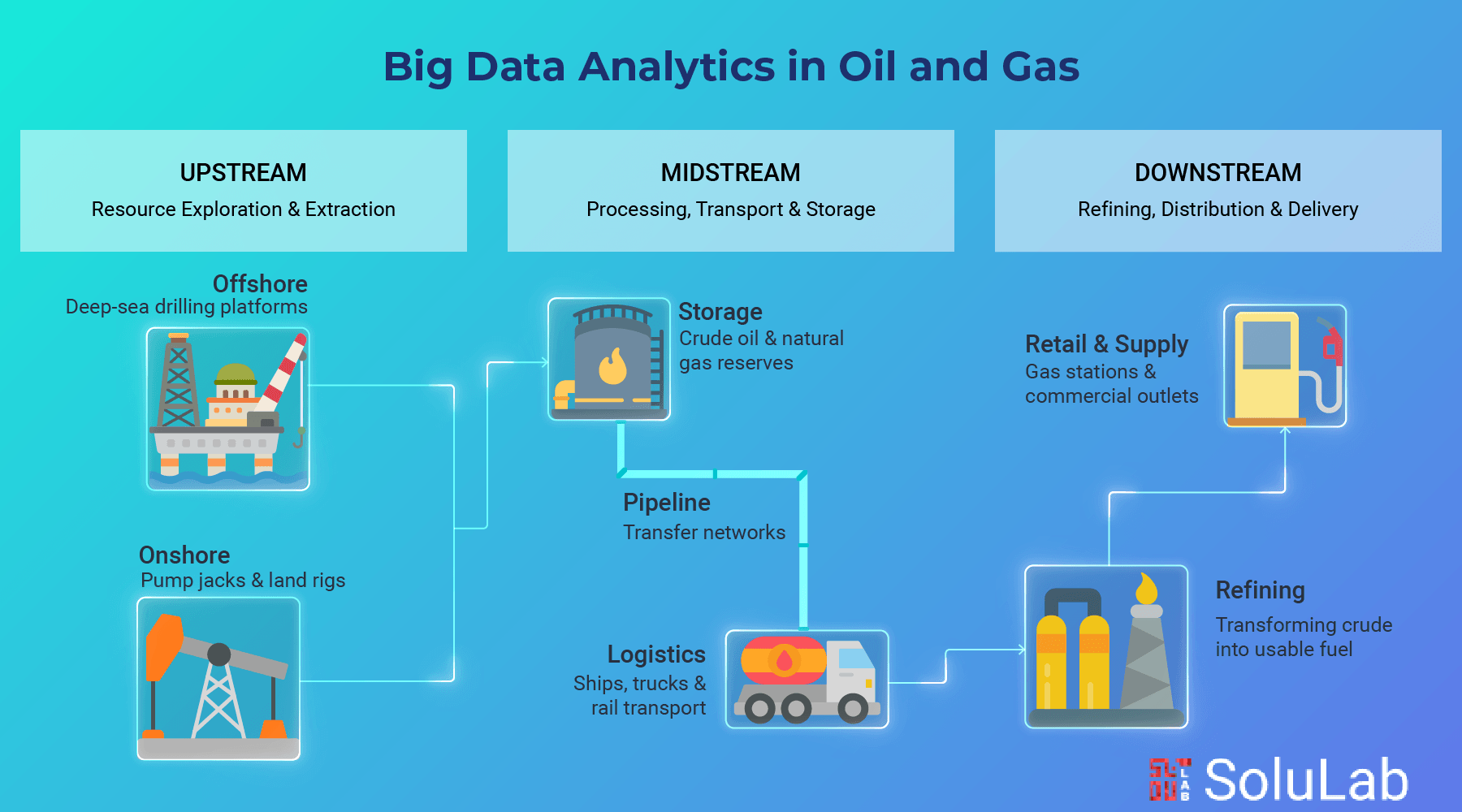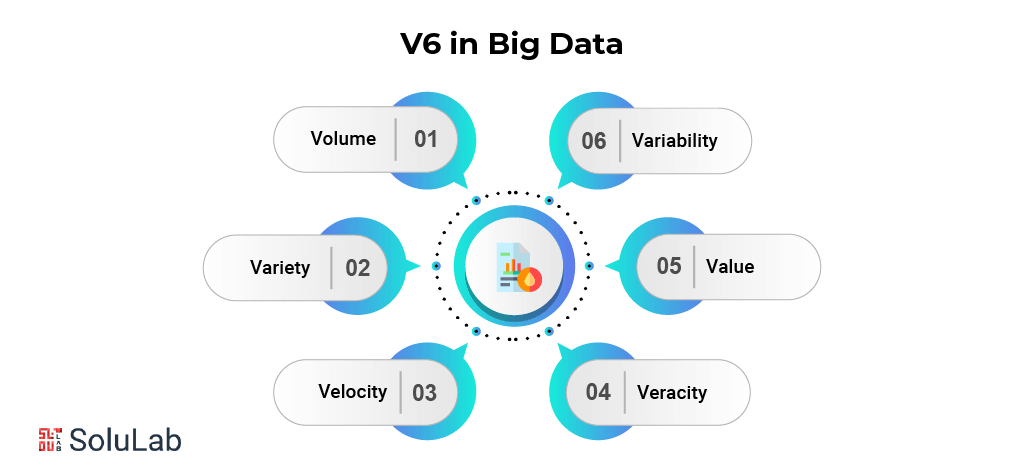
Big data is changing how companies make decisions in almost every industry. It helps them figure out what’s working, what’s not, and how to do things better. While some industries are just starting to use big data, oil and gas companies have been doing it for a long time. They’ve always relied on tons of data to make smart choices. These companies use tools like visualization software and seismic technology to study what’s hidden deep under the Earth.
But now, with more data than ever before, they know they need even smarter analytics to stay ahead. By improving how they use data, they can boost their operations and make more money.
In this article, we’ll explore how big data is helping the oil and gas industry become faster and more efficient.
A report by Globe Newswire says the big data analytics market will hit $1.2 trillion by 2032, growing by 14.5% every year. That’s a lot of data!
Big Data Analytics in the Oil and Gas Industry: Overview
The world is going through a lot of technological shifts, with an increasing amount of work being done online for anything from grocery shopping to fighting wars. This online activity can now be tracked, monitored, and stored. The vast amount of data generated has given rise to the concept of big data, which refers to massive datasets that are challenging to manage using traditional methods.
The data produced by the oil and gas sector must include at least a number of the big data attributes mentioned above to be used for big data analytics. Let’s examine each of the traits that are shown by the data produced by the oil and gas sector. Big data is defined by six key characteristics, often referred to as the six Vs:

- Volume: The development of data recording sensors is what creates big data in the oil and gas sector. Better data collection is made possible by these sensors during the drilling, exploration, and prediction processes.
- Variety: Big data can contain unstructured, semi-structured, or structured data, as was covered in the preceding section. Through applications about surveys, exploration data, and other production-related aspects, the oil and gas sector produces structured data. Emails, market feeds, site images, and other sources provide the semi-structured data.
- Velocity: Because there is a substantial risk of death and serious injury in the oil sector, real-time decision-making is crucial. Because of this, the oil sector places a strong focus on combining and synthesizing various data sources, which significantly increases the rate of data output.
- Veracity: The oil and gas sector can benefit from the effective application of big data analytics in several ways, including seismic processing, reservoir modeling, and sensor calibration, which support various phases of the production, delivery, transportation, and exploration of oil.
- Variability: Data in the oil business can take many different forms, as was previously discussed. As the earth’s surface is scanned for oil, the data may be in the form of pictures and movies, or it may be produced by sensors and other surveys as conventional structured numerical data.
- Value: Finally, the oil business benefits greatly from investments in big data analytics. It aids in oil exploration, navigation, and visualization and improves drilling procedures to lower costs, increase safety, boost output, etc.
Benefits of Big Data Analytics in the Oil and Gas
Big data analytics has completely changed the oil and gas sector. When it comes to big data use cases in oil and gas, multifarious concepts use this high-tech feature. Not just that, it offers many advantages that improve productivity, security, and profitability. Here are a few of the main benefits:
1. Drilling and Exploration
Businesses can cut down on the time and expense of exploration by using large databases to drive their drilling decisions. For instance, by using data analytics and sensor deployment, ConocoPhillips achieved a 50% reduction in drilling time in the Eagle Ford shale region in South Texas.
2. Predictive management
Predictive maintenance is made possible by big data analytics, which forecasts possible problems by examining equipment data. This method lowers maintenance expenses and decreases unscheduled downtime. Predictive analytics, for example, has been utilized by the oil and gas industries to reduce maintenance costs and downtime of processing equipment.
3. Optimization of Operations
Businesses can find inefficiencies and procedures by analyzing data from many operations. Cost reductions and better resource management result from this. Businesses can use big data analytics to turn massive datasets into wise exploratory choices and lower operating expenses.
4. Mitigation of Risk
By examining trends and irregularities in data, big data analytics assists in spotting possible hazards. This proactive strategy lowers environmental risks and improves safety procedures. Predictive analytics, for instance, can detect operational disruptions and hazard events during industrial operations, enabling prompt responses.
5. Decision Making
Decision-makers are empowered with actionable insights when they have access to real-time data and advanced analytics. As a result, choices are made more quickly and accurately, improving overall corporate performance. Businesses can enhance resource management, optimize drilling procedures, and forecast equipment breakdowns by applying advanced data analysis techniques.
6. Cost Reduction
Significant cost savings across a range of businesses can result from the use of big data analytics. To improve exploratory decision-making and possibly lower operating costs, BP and Palantir Technologies, for example, have partnered to use artificial intelligence.
In conclusion, big data analytics has a lot to offer the oil and gas sector, from improving the effectiveness of exploration to lowering operating expenses and risks. Using data analytics will be essential for sustaining competitiveness and attaining sustainable growth as the industry develops further.
Components of Big Data Analytics in the Oil and Gas

Application of big data analysis in oil and gas industry enables oil and gas companies to find new growth prospects. It cannot function in a vacuum. Let’s examine the various components of big data analytics that have the potential to revolutionize the following industries.
1. Data Collection
Data collection, which can take the form of structured or unstructured data gathered from various sources such as IoT sensors, seismic surveys, satellite imaging, mobile applications, and cloud services, is the first crucial step towards data analytics in the oil and gas sector.
To automatically assign metadata for improved accessibility and management, enterprises must modify their data-gathering tactics and merge data from many sources into centralized repositories. DBMS software, data lakes, and data warehouses are examples of these centralized data stores.
2. Information Processing
Processing the data, organizing, extracting, and loading it into storage systems like MongoDB, NoSQL, Google Cloud Storage, Apache Cassandra, etc., becomes essential after it has been gathered.
Data processing uses data aggregation and type conversion to change raw data into a format that can be used. Large volumes of dispersed datasets can be processed more quickly and efficiently with the aid of tools like Apache Spark and Hadoop.
Businesses can process enormous volumes of data over long periods and smaller volumes of data in real time with the use of strategies like batch processing and stream processing.
3. Advanced Analytics Techniques
Extracting insights from historical and real-time data requires the use of sophisticated analytical techniques, including data mining algorithms, machine learning, deep learning, and predictive analytics.
These methods help companies make well-informed decisions by allowing them to spot trends, estimate production results, anticipate equipment faults, and more.
4. Tools for Visualization
Visualization tools are another crucial component of big data analytics. To obtain a comprehensive grasp of the present operational stage, these technologies assist businesses in converting complex data into actionable insights through dashboards, reports, interactive operational data, etc.
In addition, incorporating 3D modeling tools into the oil and gas industry allows for the precise visualization of reservoirs and drilling operations, which helps engineers and geoscientists plan and execute operations effectively.
5. Governance and Data Security
Because of the growing dangers of cyberattacks, data security is crucial in today’s environment. Access control systems and encryption technologies are essential for avoiding unwanted access to sensitive data in software used by the oil and gas sector.
Effective data quality management techniques are also essential for fostering data accuracy, consistency, and dependability, all of which support well-informed decision-making and regulatory compliance.
Real-life examples of Big Data Analytics in the Oil and Gas
Big data is improving the oil and gas industry, helping companies improve efficiency, reduce risks, and make smarter decisions. Here are some real-life examples of how it’s being used.
1. Royal Dutch Shell
Shell uses big data to make smarter decisions. They have thousands of oil wells, and keeping them running smoothly is a big challenge. By using data from sensors, Shell can predict when a machine might break down.
This helps them fix it before it causes a problem, saving time and money. Plus, they use data to find the best drilling spots by analyzing rock formations and underground conditions.
2. Bharat Petroleum
Bharat Petroleum uses big data to improve fuel quality and customer service. They collect data from their fuel stations to track fuel demand, pricing, and customer behavior.
With this information, they can make better decisions about where to open new stations or how to adjust fuel prices. They also use data to prevent fuel theft by spotting unusual patterns.
Future Trends of Big Data Analytics in Oil and Gas
Big data analytics is leading the way in innovation and productivity within the oil and gas industry. The following major trends are shaping how big data analytics will improve in this sector in the future:
1. Integration of ML and AI
Since they make more precise predictions and facilitate automatic decision-making, AI and ML are becoming essential components of big data analytics for the oil and gas industry. Through the utilization of large language models to sift through operational information and deliver actionable insights, companies like BP are pushing the frontiers of AI application to refine decision-making processes.
2. Computing and real-time data processing
Computing is enabling the processing of data in real time at far-flung locations, including oil rigs and drilling pads. The innovation reduces latency and improves decision-making through feedback on ambient conditions and equipment performance.
3. Predictive Maintenance
Companies can minimize downtime and maintenance expenses by foreseeing equipment failure and applying big data analytics for predictive maintenance. Drones with AI, for example, are now employed for distant monitoring, making it possible for immediate interventions to be made while reducing operational stoppages.
Read Also: How to Build a Predictive Analytics Model?
4. Data-Driven Sustainability Initiatives
By optimizing resource use and minimizing environmental footprint, big data analytics is also a key driver of sustainability. Companies are aligning their operations with international sustainability objectives by making investments in low-carbon technology and leveraging data to track and reduce emissions.
5. Supply Chain Efficiency
Companies can recognize inefficiencies and improve logistics by analyzing data along the supply chain, which reduces costs and accelerates delivery. Supply chain performance is improved by big data analysis that allows for improved inventory management and forecasting demand.
Conclusion
The oil and gas sector, like many others, is becoming more aware of the advantages of big data analytics. Big data analytics uses a range of data, including production rates, seismic data, drilling rig data, frack performance data, and more, to help the oil and gas industry make well-informed decisions.
Big data analytics will most certainly play a significant role in oil and gas organizations in the future, though, given the advantages of identifying possible oil sources, producing oil efficiently, lowering costs and risk, and improving compliance and decision-making.
SoluLab, being the pioneer in software development, holds years of experience and is backed by a team of professionals who are always ready to cater to your business needs. Even in the case of the oil and gas industry, we are rendering on-demand applications to ease your business operations with high tech solutions. Still unsure of your business plan, get in touch with experts and get started today!
FAQs
1. How is big data analytics shaping the oil and gas industry?
It boosts efficiency, reduces downtime, improves exploration accuracy, and helps companies make data-driven decisions for better performance and profitability.
2. What is the cost of developing big data analytics software for oil and gas companies?
It ranges from $50,000 to $500,000+, depending on the complexity, features, and customization required.
3. What are the major big data analytics trends that will improve operations in the oil and gas industry?
AI, computing, predictive maintenance, real-time monitoring, and sustainability analytics are changing operations and boosting efficiency.
4. Why must oil and gas companies act on analytics?
To stay competitive, reduce costs, boost productivity, and make smarter, faster decisions based on real-time insights.
5. What is data analytics in the oil and gas industry?
Data analytics in the oil and gas industry means using data from drilling, production, and operations to make smarter decisions. It helps improve efficiency, reduce costs, predict failures, and boost profits.





